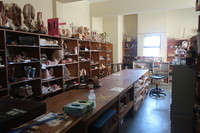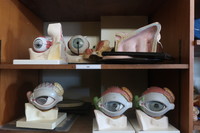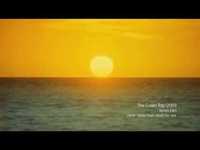Items
keywords is exactly
eyes
-

The workshop
"Held in the Department of Human Biology in the Division of Clinical Anatomy and Biological Anthropology, this collection consists of prepared specimens – both bottled and plastinated, anatomical models – and a skeletal repository used for research purposes. The materials are kept in three separate rooms, with the anatomical models in one, the prepared and plastinated specimens in another and the skeleton repository in its own room behind locked doors, viewable by appointment only. The room housing the anatomical models functioned as a workshop when modelmaking was still offered to first year medical students as an elective course: its walls are lined with shelves that display models made from materials ranging from papier-mâché to modern silicon copies and are taxonomised according to their anatomical representations, such as ‘the eye’, ‘head & neck’, ‘dentistry’, ‘embryology’, ‘lungs’ and ‘cardiovascular system’, to name a few. The models represent each anatomical section and are brightly coloured to differentiate the different parts of the human body and aid in identification. Many of the models can be dismantled into separate pieces and, like a puzzle, be reassembled into their original shapes. Interspersed with these models are rolled-up charts depicting organs, bodily systems and anatomical sections of the body in two-dimensional form, as well as old student modelling projects. A selection of animal skeletons is displayed on the far side of the room, and a shelf with a few anatomical specimens in formaldehyde is across from it" (Liebenberg 2021: 121 - 122). -

Seeing
Educational models found in the Anatomy workshop: "Borrowing from Herbert Read’s art historical discussion on looking, Digby posits that the biomedical practitioner’s generally critical attitudes were shaped in part by their limited recognition of indigenous medicine during this period – ‘what we see is inseparable from how we see; the eye is not innocent, and vision is partial’ (Digby 2006: 356) and, quoting Read, ‘we see what we learn to see, and vision becomes a habit, a convention, a partial selection of all there is to see’ (in Digby 2006: 356). Accordingly, Digby argues that the Western practitioners would have had, at best, only a partial view of the different medical systems in South Africa during this period (Digby 2006: 357) and probably only to the extent that it was a threat to their own livelihood and authority – as evidenced in the 1928 Medical, Dental and Pharmacy Act that Floyd helped instate" (Liebenberg 2021: 55). -

The Green Ray (Jules Verne)
"At last only a faint rim of gold skimmed the surface of the sea. 'The Green Ray! the Green Ray!' cried in one breath the brothers, Dame Bess and Partridge, whose eyes for one second had revelled in the incomparable tint of liquid jade. Oliver and Helena alone had missed the phenomenon which had at last appeared after so many fruitless observations. Just as the sun was shooting its last ray into space their eyes met, and all else was forgotten in that glance. But Helena had caught the black ray, shining from the young man's eyes, and Oliver the blue ray beaming from hers. The sun had gone down, and neither Oliver nor Helena had seen the Green Ray" (Verne 1883:136). -

Zinc Sulphate
"Astringent. One or two dissolved in an ounce of water, will be found useful as an eye-lotion, and as an injection or astringent lotion" (BWC 1925:144).


